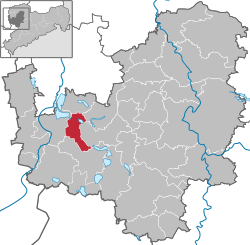Böhlen
For Böhlen in Thuringia, see Böhlen, Thuringia.
| Böhlen | ||
|---|---|---|
| ||
 Böhlen | ||
Location of Böhlen within Leipzig district  | ||
| Coordinates: 51°12′9″N 12°23′9″E / 51.20250°N 12.38583°ECoordinates: 51°12′9″N 12°23′9″E / 51.20250°N 12.38583°E | ||
| Country | Germany | |
| State | Saxony | |
| District | Leipzig | |
| Government | ||
| • Mayor | Maria Gangloff (Die Linke) | |
| Area | ||
| • Total | 24.55 km2 (9.48 sq mi) | |
| Population (2015-12-31)[1] | ||
| • Total | 6,770 | |
| • Density | 280/km2 (710/sq mi) | |
| Time zone | CET/CEST (UTC+1/+2) | |
| Postal codes | 04564 | |
| Dialling codes | 034206, 034299 (Großdeuben) | |
| Vehicle registration | L, BNA, GHA, GRM, MTL, WUR | |
| Website | www.stadt-boehlen.de | |
Böhlen (German pronunciation: [ˈbøːlən]) is a town in the Free State of Saxony, Germany, south of Leipzig. Its main features are a small airport and a power-plant. It is located in the newly built Neuseenland, the lakes created in the former open-pit mining areas.
History
The first documented mention of Böhlen dates to 1353. The character of the place was rural for a long time. Only from the 1920s did the then village develop into an industrial area, mainly due to the lignite found in the area. The first lignite mine in the area was opened in 1924.
Towards the end of World War II a subcamp of Buchenwald concentration camp was established, where 800 prisoners worked as forced labor in a Braunkohle-Benzin AG ("Brabag") plant.
References
This article is issued from Wikipedia - version of the 7/19/2015. The text is available under the Creative Commons Attribution/Share Alike but additional terms may apply for the media files.
